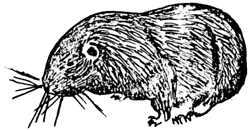“Yellow” Scarlet Gilia
By O. L. Wallis, Ranger-Naturalist
In the area west of Vidae Ridge, on August 2, I discovered two plants of scarlet gilia (Gilia aggregata (Pursh) Spreng.) with lemon yellow flowers. One plant was 45 cm tall and had 56 flowers. The second had three stems, the longest of which was 33 cm; 25 flowers grew on the three stems. Although mutants of this type are comparatively rare, Ranger-Naturalist Elmer I. Applegate collected one such plant on August 1, 1939, on the road below the old campgrounds. This plant had five stems, the longest of which was 32 cm, and bore a total of 55 flowers.
Brown Mountain Beavers
By O. L. Wallis, Ranger-Naturalist
 Confined to the Pacific Northwest, mountain beavers are grouped into the single rodent family Aplodontiidae, into one genus Aplodontia and into one species rufa, divided into nine subspecies. The mammal has several other names: sewellel (Indian name), boomer, and mountain burrower. Of these, the last is the most appropriate; forAplodontia is only distantly related to the American Beaver (Castor canadensis), the builder of dams and lodges. Differing in habitat, the mountain beaver lies in a series of underground tunnels, six to seven inches in diameter, with many external openings that are connected, above ground, by a network of runways. There are two types of openings: The one for general use is kept fairly clean and is used as an entrance and exit. The other type of burrow is employed as a refuse opening, through which the rocks and dirt of excavation are pushed forth.The brown mountain beaver (Aplodontia rufa rufa Rafineque), furnishes one of the most individual forms of animal life in Crater Lake National Park, interesting not only because it is one of the most primitive mammals in existence but also because of its limited range, its lack of close relatives, and its intensive food storing activity.
Confined to the Pacific Northwest, mountain beavers are grouped into the single rodent family Aplodontiidae, into one genus Aplodontia and into one species rufa, divided into nine subspecies. The mammal has several other names: sewellel (Indian name), boomer, and mountain burrower. Of these, the last is the most appropriate; forAplodontia is only distantly related to the American Beaver (Castor canadensis), the builder of dams and lodges. Differing in habitat, the mountain beaver lies in a series of underground tunnels, six to seven inches in diameter, with many external openings that are connected, above ground, by a network of runways. There are two types of openings: The one for general use is kept fairly clean and is used as an entrance and exit. The other type of burrow is employed as a refuse opening, through which the rocks and dirt of excavation are pushed forth.The brown mountain beaver (Aplodontia rufa rufa Rafineque), furnishes one of the most individual forms of animal life in Crater Lake National Park, interesting not only because it is one of the most primitive mammals in existence but also because of its limited range, its lack of close relatives, and its intensive food storing activity.
Burrows are usually located in a moist area, on a hilly slope where the soil is relatively loose, where springs exist, and the vegetation is dense. During my summer’s observations, I have noted the (inner) workings near Vidae Falls, in Castlecrest Gardens, in the springy area below the Gardens, and on the south slope of Munson Ridge near the Park Headquarters. In all of these workings, water was found to be trickling through at least a section of the tunnel system throughout the entire summer. For such a timid animal, water supply of this type proves to be protective as well as convenient. The creature is able to drink in perfect safety within the confines of its dwelling; also, the running water offers a means of disposal of waste vegetation material which readily floats out of the lower end of the burrow.

